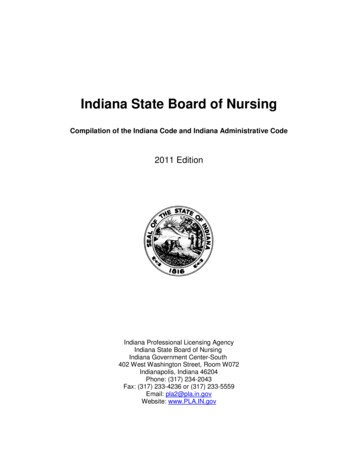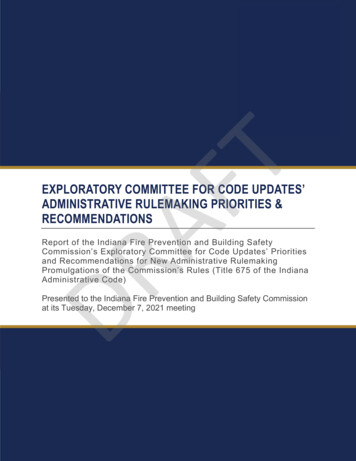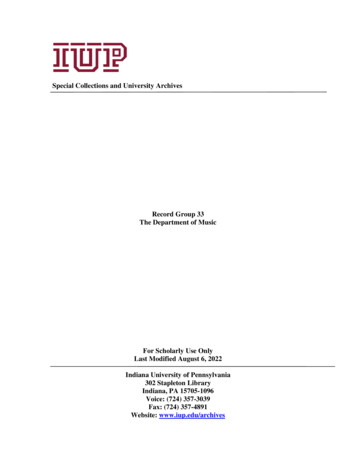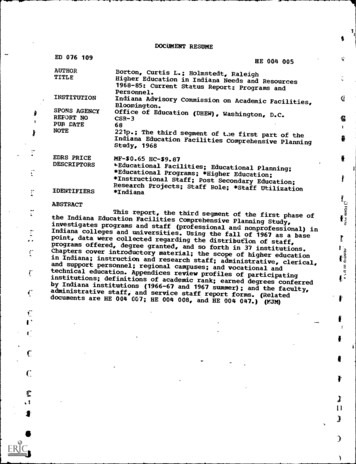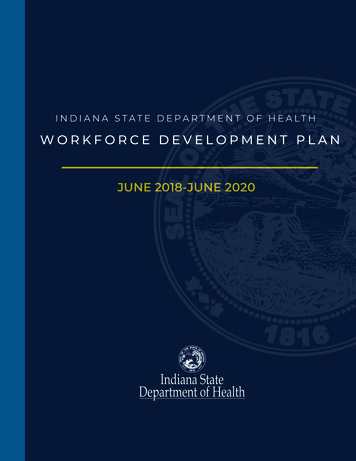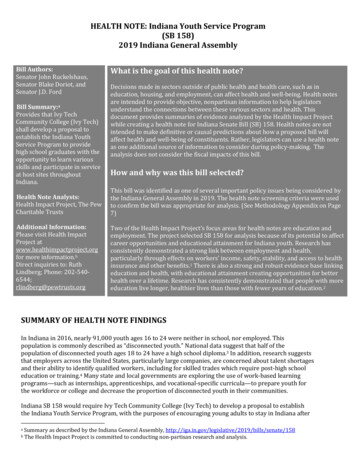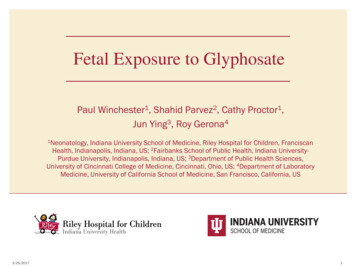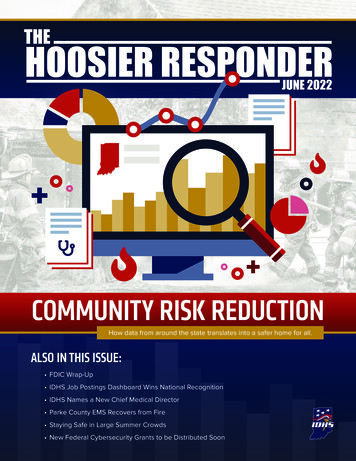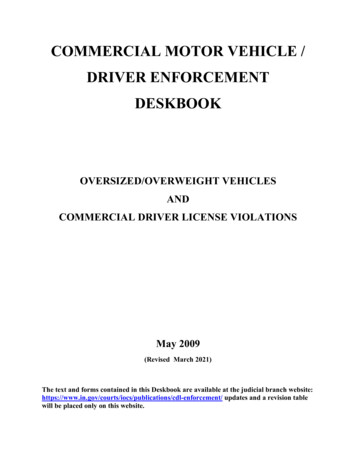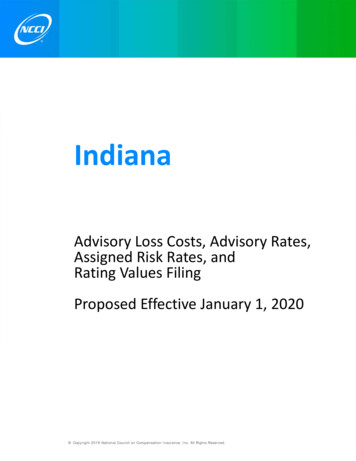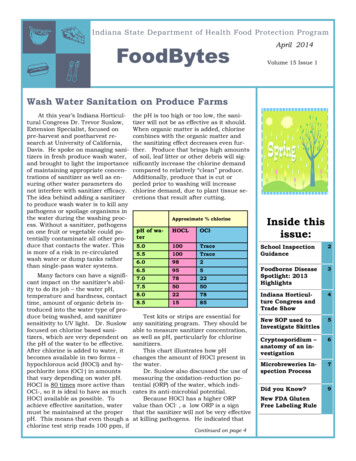
Transcription
Indiana State Department of Health Food Protection ProgramFoodBytesApril 2014Volume 15 Issue 1Wash Water Sanitation on Produce FarmsAt this year’s Indiana Horticultural Congress Dr. Trevor Suslow,Extension Specialist, focused onpre-harvest and postharvest research at University of California,Davis. He spoke on managing sanitizers in fresh produce wash water,and brought to light the importanceof maintaining appropriate concentrations of sanitizer as well as ensuring other water parameters donot interfere with sanitizer efficacy.The idea behind adding a sanitizerto produce wash water is to kill anypathogens or spoilage organisms inthe water during the washing process. Without a sanitizer, pathogenson one fruit or vegetable could potentially contaminate all other produce that contacts the water. Thisis more of a risk in re-circulatedwash water or dump tanks ratherthan single-pass water systems.Many factors can have a significant impact on the sanitizer’s ability to do its job – the water pH,temperature and hardness, contacttime, amount of organic debris introduced into the water type of produce being washed, and sanitizersensitivity to UV light. Dr. Suslowfocused on chlorine based sanitizers, which are very dependent onthe pH of the water to be effective.After chlorine is added to water, itbecomes available in two forms –hypochlorous acid (HOCl) and hypochlorite ions (OCl-) in amountsthat vary depending on water pH.HOCl is 80 times more active thanOCl-, so it is ideal to have as muchHOCl available as possible. Toachieve effective sanitation, watermust be maintained at the properpH. This means that even though achlorine test strip reads 100 ppm, ifthe pH is too high or too low, the sanitizer will not be as effective as it should.When organic matter is added, chlorinecombines with the organic matter andthe sanitizing effect decreases even further. Produce that brings high amountsof soil, leaf litter or other debris will significantly increase the chlorine demandcompared to relatively “clean” produce.Additionally, produce that is cut orpeeled prior to washing will increasechlorine demand, due to plant tissue secretions that result after cutting.Approximate % chlorinepH of 78227.550508.022788.51585Test kits or strips are essential forany sanitizing program. They should beable to measure sanitizer concentration,as well as pH, particularly for chlorinesanitizers.This chart illustrates how pHchanges the amount of HOCl present inthe water.Dr. Suslow also discussed the use ofmeasuring the oxidation-reduction potential (ORP) of the water, which indicates its anti-microbial potential.Because HOCl has a higher ORPvalue than OCl- , a low ORP is a signthat the sanitizer will not be very effectiveat killing pathogens. He indicated thatContinued on page 4Inside thisissue:School InspectionGuidance2Foodborne DiseaseSpotlight: 2013Highlights3Indiana Horticulture Congress andTrade Show4New SOP used toInvestigate Skittles5Cryptosporidium –anatomy of an investigation6Microbreweries Inspection Process7Did you Know?9New FDA GlutenFree Labeling Rule
Meet the new Consumer Specialist—Kris GaspericKris is originally fromNew Berlin, a suburb of Milwaukee, WI. She is acheesehead who loves theGreen Bay Packers, but is aColts fan as long as they donot play each other.Kris graduated from theUniversity of Wisconsin –Milwaukee in 1993 with aBachelor of Science in Biological Science. Her firstposition out of college wasat Swans Environmental, anenvironmental lab, whereshe did organic samplepreparation and sample receiving for about threeyears. That company closedand she then found a position at Foran Spice Company. There she made custom spice blends and wroteingredient statements. Afterabout six months, in No-vember 1996, Kris was offered a position withMilwaukee Cooperative Milk Producers. As alab technician, she tested raw milk for butterfat, protein, Llctose, other solids and somaticcells along with bacteria and antibiotics forproducer pay. In 2006, Kris became the labmanager.In the fall of 2012, for a variety of reasons,Kris made the decision to change her life dramatically. She left her lab manager positionin Brookfield, WI to find a new life and careerin Indianapolis. As the new Consumer Specialist, Kris will be responsible for recalls,complaints, and sampling. She looks forwardto working with everyone!by Sharon Pattee, MFRPSISDH Training and Auditing CoordinatorSchool Inspection Guidance now available to LHDsThe Department of Education (DOE), School andCommunity Nutrition, andISDH Food Protection Program (FPP) collaborated toprovide the first ever schoolinspection guidance for Local Health Departments(LHDs). Sarah Kenworthyand John Todd, DOE,worked with Sharon Farrelland Dan Miller, ISDH FPP,to design this new resource.According to the most recentDOE data, improvementswere needed to assure thatall sites get inspected. Oneof the requirements of theRichard B. Russell NationalSchool Lunch Act is thateach site participating inthe National School Lunch(NSLP) and Breakfast Programs (SBP) must obtaintwo food safety inspectionseach school year, which is areporting period of July 1June 30. The Summer FoodService Program (SFSP)must have one inspection.Identified by the authorsof the guidance was a needfor an easier way for LHDsPage 2to know what programsneeded inspections. Thisneed resulted in a reengineered list where allsites are listed under thecounty that inspects ratherthan the county where theschool sponsor is located.In addition, sponsors arerequired to notify the LHDsif they open a site, at leasttwo weeks prior to opening.This is helpful to learnabout new summer sites.SFSP often opens a new location just for the summerand this site may not be onthe list.If a LHD is not able toget all the required inspections scheduled, they havethe option of giving the sitea letter verifying this fact.This will allow the sponsorto receive reimbursementthat would otherwise be denied if they did not obtainthe inspections.The United States Department of Agriculture(USDA) is serious about foodsafety and requires sites topost the LHD inspections.Other than prisons and mental health facilities, the LHDs are responsible for most schoolsite inspections. Also identified by the groupwas some confusion being reported about theFood Safety HACCP plans required by USDA.HACCP plans are required but inspectors arenot required to review them.State Legislation Programsby Gordon W. Gunderson“By 1937,15 States had passed laws specifically authorizing local school boards tooperate lunchrooms. Although the lawscommonly authorized the serving of mealsat cost, usually the cost of the food only,four States made special provisions forneedy children. In Indiana (for cities ofover 300,000 inhabitants -Indianapolis wasthe only one), and in Vermont, the boardswere authorized to furnish lunch withoutcost to poor children, and in Missouri (forcities over 500,000 -St. Louis was the onlyone and Wisconsin at less than costprices.”The Bureau of Agricultural Economics, USDA, TheSchool Lunch Program and Agricultural Surplus Disposal, Miscellaneous Publications No. 467, October1941.Foodbytes
Foodborne Disease Spotlight: 2013 Enteric DiseasesThe ISDH is continually working to improve the enteric diseaseoutbreak reporting capabilities.As a result, the ISDH investigated120 enteric disease outbreaks in2013. Comparatively, in 2012, theISDH investigated 28 enteric disease outbreaks.Enteric disease outbreaks aredefined as two or more cases ofsimilar illness associated with acommon exposure, outbreaks withcases within the same household,or a single case of foodborne botulism and foodborne toxin.raw fruits and vegetables.the food production chain are important to preventing future foodborne outbreaks. Improving theNorovirusability to detect and respond toTransmission of norovirus can outbreaks will hopefully in turnimprove foodborne illness prevenoccur by contacting with an infected person, consuming contami- tion techniques and ultimatelyreduce the burden of enteric disnated food or water or touching acontaminated object. While norovi- eases across Indiana.rus infections can occur any timethroughout the year, they are mostcommon during the wintermonths. In the United States,http://www.cdc.gov/salmonella/oabout 50 percent of food-relatedutbreaks/reporting timeline.htmlillness outbreaks are caused bynorovirus. Any food that is servedInvestigating enteric diseaseoutbreaks requires a collaborative raw or handled after being cooked http://www.cdc.gov/norovirus/trcan become contaminated; howeffort from state and local partends-outbreaks.html#trendsever, foods most commonly associners. In the case of multistateated with norovirus infections inoutbreaks and some instate outbreaks, collaboration also include clude leafy greens, fresh fruits and tmlfederal partners. Of the 120 enteric disease outbreaks in Indianain 2013, 38 were multistate invesShiga toxin-producing E. )utbreaks/preventionAmong the 120 outbreaks ofeducation/future.htmlOutbreaks of STEC infectionsenteric diseases, the most commonly identified confirmed patho- are identified by the specific straingens were Salmonella (44), Norovi- infecting individuals or contamiby Tess Gordon, ISDHnating food. E. coli O157:H7 is therus (18) and Shiga toxinEnteric Epidemiologistproducing E. coli (14). Additionally most common strain associated31 suspected Norovirus outbreaks with outbreaks of STEC. Foodsources commonly associated withwere investigated by Indiana inE. coli O157:H7 infections include2013.undercooked beef (especially hamburger), unpasteurized milk andjuice, raw fruits and vegetablesSalmonella(e.g., sprouts) and contaminatedOutbreaks of Salmonella infec- water.tions are often identified throughAll enteric disease outbreaksa type of “DNA fingerprinting” onareto be reported immediately toSalmonella laboratory samples,theISDH Contact the District Fieldknown as pulse-field gel electroEpidemiologist or the Enteric Epiphoresis (PFGE). In most cases,bacteria with the same PFGE pat- demiologist to report an outbreaktern indicate a common source of during normal business hours.exposure. With PFGE testing, in- After hours, enteric disease outvestigators can determine if there breaks can be reported to theis a link between an infected case ISDH Duty Officer at 317-2331325.and contaminated food, water oran infected animal. Food sourcesFrom previous outbreaks, wecommonly associated with Salmo- are able to learn more about hownella infections include eggs,to prevent foodborne outbreakspoultry, meat, unpasteurized milk from happening in the future. Acor juice, cheese, contaminatedtions taken by many partners inPage 3ReferencesFoodBytes
Indiana Horticultural Congress and Trade ShowEach year, the Indiana Horticultural Congress draws a diverse crowd of attendees fromevery aspect of the produce industry, from organic growers, towine producers, to processors.The congress was held January21-23, 2014 in Indianapolis, andhosted a variety of educationalsessions, including updates onproduce quality, food safety, pestmanagement, product marketingand production practices. ISDHFood Safety Farm ConsultantJennifer Coleman presented anupdate on the produce safety initiative and its activities over thecourse of the past year. The program was implemented in 2013after recognizing the need to address food safety on producefarms. Throughout the year, theFarm Consultants conducted onsite visits to review farming andfood handling practices, discussing with growers any practicesneeding improvement. It wasnoted that common problem areas throughout Indiana were alack of well water testing, usingunsuitable materials for foodcontact surfaces and inadequatesanitation practices.They demonstrated the use ofAdenosine Tri-Phosphate (ATP)swabs and luminometers to illustrate how ATP testing can beutilized to monitor cleaning effectiveness on the farm. Withfarms varying widely in size,type and complexity, it is clearthat it will be necessary to findworkable solutions that addressthe individual needs of eachfarm.Farm Consultants also conducted surveillance sampling ofproduce from a variety of locations, including farmers’ markets, retail food establishmentsand directly from producefarms. They followed up positivetest results with on-farm assessments to determine if farmpractices may have contributedto contamination. Environmental samples, including soil,water and equipment swabswere collected as needed to further identify sources of contamination. Recommendations forthe improvement of specificpractices were made as necessary, and outlined in letterssent to the grower. Producesample results for the year werelargely negative for pathogens,with a few exceptions where Salmonella was found on produceand in soil and Listeria monocy-togenes was found on produceand equipment.Several educational opportunities were available to growers in2013, including good agriculturalpractices workshops offered byPurdue University Extension, aswell as on-farm packing shedsanitation workshops hosted byPurdue food scientists and ISDH.ISDH and Purdue hope to providemore educational opportunitiesthis year, allowing for a morehands-on experience for growers.Throughout 2014, the Farm Consultants will continue to assistgrowers in developing food safetyplans, reviewing farm and packingshed practices, identifying bestpractices from other states andworking with industry and academia to develop solutions for Indiana farms. The HorticulturalCongress provided a great opportunity for the Farm Consultantsto learn more about the produceindustry while opening the dialogue between ISDH and localgrowers in the interest of publichealth.by Jennifer Coleman,ISDH Food SafetyFarm ConsultantWash Water Sanitation on Produce Farms(continued from page 1)30 seconds with ORP values above650mV. Growers who utilize thistypically use either hand heldprobes or in-line sensors thatprovide continuous monitoring ofORP values.Another reason it is importantto maintain wash water quality isthe potential for internalization ofwater into the produce. Whenfruits or vegetables are submergedduring washing, water may bedrawn into their flesh if the temperature of the water is more than10 F colder than the temperaturePage 4of the produce. Any pathogenspresent in the water may be internalized as well, presenting aproblem for produce that is likelyto be eaten raw.Dr. Suslow stressed that withthe availability of many differenttypes of sanitizers on the market,growers should consider the advantages and disadvantages ofeach when choosing one that willbe appropriate for their operation.Some are less affected by organicdebris, some are less affected bypH, some are less corrosive andsome provide residual anti-microbial activityon the surface ofproduce afterwashing. Theoverarching message was thatthere is no “onesize fits all” sanitizer, and regardless of what kind is used, growersshould be aware of its limitations,what parameters to monitor andhow to monitor them.by Jennifer Coleman,ISDH Food SafetyFarm ConsultantFoodBytes
New SOP Used to Investigate Skittles ComplaintThe recent Skittles related illnesses reported in Richmond,Indiana presented the ISDH’s FPPwith the opportunity to utilize itsFoodborne Illness Investigationand Recall written standard operating procedures which provedvery useful. A Standard Operating Procedure (SOP) is a document that details the necessaryactions that are taken when performing a task. The SOP can bethought of as a manual used inperformance of a duty. SOPs arewidely utilized in various industrysegments like laboratories, healthcare establishments and the military to mention a few.ISDH FPP has adopted theVoluntary National Retail FoodRegulatory Program Standards(VNRFRPS). A key tenet ofVNRFRPS is the need to havewritten guidelines or SOPS for theactions undertaken by the FPP.This helps to defines terms, clarifyroles and responsibilities as wellas spell out the activity-tree orflow chart to carry out a proce-dure.There are a number of advantages to having written SOPs.These can include ensuring uniformity in the enactment and enforcement of policy by food inspectors in a jurisdiction. The actionsof staff members can be evaluatedbased on how well the policy isbeing implemented. SOPs can alsoserve as a training aid for foodinspectors.The creation of an SOP shouldbe an ongoing process not a made-and-done document. Constantimprovement and predeterminedreview interval of SOPs is criticalto its usefulness and effectiveness. The existence of an SOPshould not exclude personal initiative as well as flexibility whichare essential in carrying out theactivities that protect the safety ofthe public’s food supply. If youhave any questions on how tocreate and use SOP or want toknow more about VNRFRPS andhow it relates to the work of theFPP, please do not hesitate to contact Stephen Fakoyejo, VNRFRPSCoordinator, by phone at 317-233-8476.By Steven Fakoyejo, VNRFRPSgrant coordinator“Who is this ?”see page 7Not for Profit Food Safety TrainingA new food safety training,“Cooking for Groups”, is availablethrough IN-Train. IN-Train standsfor Indiana Training Finder Realtime Affiliate Integrated Network(IN-TRAIN) and is sponsored by theISDH Office of Public Health Performance ManagementWith IN-Train, it is now possible to provide training programsfor the public as well as internalpartners.It is estimated that thousandsof Indiana volunteers serve foodeach year at festivals, schoolevents, church dinners, fairs andfood banks. Most volunteers donot work in food service on a routine basis and may not be aware ofcurrent best practices. Traditionaltraining is often too costly for volunteers or takes too long to comPage 5plete. “Cooking for Groups” is a 20minute basic overview availableCDC records show that manyoutbreaks result from theseevents and are contributing tofoodborne illness rates, especiallyin the summer months.Statistics can be found aspx24/7 at no cost. An endorsementvideo created by Indiana not forprofit organizations is part of thePurdue Extension and ISDH FoodProtection collaboration. Registration is required allowing ISDH access to records of who has trainedand can then be shared.CDC has written an articleabout Food Safety at Fairs andFestivals found at: http://www.cdc.gov/Features/FairsAndFood/by Sharon Farrell,ISDH Food Protection Specialist.FoodBytes
CRYPTOSPORIDIUM - Anatomy of an InvestigationAlthough there was no finalsource located, this article describes a recent investigation andthe process and the partnershipsneeded to thoroughly investigatean outbreak. Pictures were takenduring the investigation and illustrate the cider manufacturing process described.constructing a diagram of producers, distributers and farms linkedOn November 15, 2013, Elkhart County health officials notified the ISDH Epidemiology Resource Center (ERC) of an elevated number in reported cases ofstate complexity, the Food andDrug Administration (FDA) wasconsulted.In total, 13 environmentalsamples were collected fromplaces where the cider was purchased or processed. All environmental samples were sent toone of three labs for sampling:ISDH laboratories received twowater samples which weretested for coliforms; Iowa laboratories received four environmental samples, two cider samples and one water sample, alltested for Cryptosporidium; andthe FDA received four samplesof apple cider for Cryptosporidium testing. All samples testedApple Pressto the three points of purchase,some of which were in Michigan.Since ISDH labs did not have thecapacity to test for cryptosporid-Grinder and ChuteCases of Unlabeled Cidercryptosporidiosis in the past sixweeks. Symptoms of cryptosporidiosis include watery diarrhea, stomach cramps, upsetstomach, fever, weight loss andvomiting. Case investigations revealed that five of the six casesreported drinking unpasteurizedapple cider in the two weeks priorto illness onset. After further investigation and follow up questionnaires, two more cases ofcryptosporidium with a commonexposure to unpasteurized applecider were identified. Case investigations and consumer complaintsidentified three locations wherethe potentially-contaminated unpasteurized ciders were purchased.The ISDH FPP sprang into action and completed a traceback,Page 6Unidentified black residue in hoseium, Iowa labs agreed to run samples for Indiana’s investigation.ISDH ERC notified MichiganState Health Department of thetraceback results to their state,but their local health departmentsreported no increased case countsof cryptosporidium. However, because of the investigation’s inter-negative for Cryptosporidiumand coliforms, therefore, the investigation was closed beforeassessments were accomplishedat the Michigan firms.Although lab results wereunable to show that the applecider was contaminated, most ofthe ill cases reported drinkingunpasteurized apple cider in thetwo weeks prior to onset, whichis consistent with the incubation period of Cryptosporidium1.Therefore, it is highly suspectthat this outbreak was introduced by unpasteurized applecider.Unpasteurized apple ciderassociated with a previous outbreak of cryptosporidiosis.2Continued on page 7FoodBytes
CRYPTOSPORIDIUM - Anatomy of an InvestigationContinued from page 6Although apple cider is acidic,Cryptosporidium is acid-tolerantand can survive in environmentslike apple cider for up to fourweeks. Consumers should drinkpasteurized or boiled ciders in order to reduce their risk of becomingill with enteric conditions such asCryptosporidium.ISDH extends its deep appreciation to Elkhart County Local HealthDepartment, LaGrange CountyHealth Department, the Iowa StateHygienic Laboratory (University ofIowa) and the FDA for their contributions to this /disease.htmlMystery Photo from page 5Do you remember Robert L.Jump R.P.S.? Bob was formerly theFood Protection Program Director.He retired in 1997 after 40 years ofservice. During his career, he was1970 President of the Indiana Association of Sanitarians. Bob is pictured here at the Food Protectionpitch-in on December 20, 2013.2Millard PS, Gensheimer KF, Addiss DG,et al. An outbreak of cryptosporidiosis fromfresh-pressed apple cider. JAMA1994;272:1592-6.by Shawna Feinman,Waterborne Epidemiologist, ISDH ERCMeet the new CodePal Specialist—Eli ShevanovEli is a contractor assisting with CodePal implementation. He is a .NetDeveloper who graduatedfrom IUPUI in 2003 andeventually found workthere at the Departmentof Biostatistics. He joinedthe Food Protection Project Team at the beginningof 2014. Eli originallycame from Kiev, Ukraine,but he lived here for a long time and is a proud citizen of the United States. He likes to play volleyballand poker with friends on weekends. He can bereached at 317-233-7605.by Irene Jamison, OTCApplication Systems Analyst/Program SupervisorMicrobreweries Inspection ProcessMicrobreweries are a limitedproduction brewery and typicallyproduce specialty beers and sellproducts locally. It is considereda craft beer industry that focuseson flavor and technique. Mostare independently owned andsome have brewpubs that brewtheir own beer for customers.Beer is a relatively safe beverage and it is not common to hearabout beer contamination. However, there are other hazards thatcan arise during production. Human pathogens do not usuallygrow in beer due to the acidityand fermentation process.As with all facilities, a brewery must undergo a preoperational inspection and a planreview of the facility whichPage 7includes floors, walls, ceilingsand ventilation. Adequate lighting, warewashing and handwashing stations and are alsoreviewed.Inspections should focus onthe 5 Foodborne Illness RiskFactors which are food from unsafe sources, inadequate cookng,improper holding temperatures,contaminated equipment andpoor personal hygiene. For abrewery, inadequate cooking andimproper holding temperaturesdo not apply. Inspections focuson ensuring the cereal grains,barley, hops and yeast are froman approved source, stored correctly, and free from pests.Equipment is inspected to ensure it is clean and sanitized andthe cleaning for “clean in place”Most sanitation methods areindustry specific and are not thetypical sanitizers found in retailfood establishments. Employeesare monitored to ensure they arepracticing good hygiene.The ISDH will inspect breweries that sell wholesale, but it isup to the local health departmentto permit and inspect if they sellretail. If any brewery acts as abrewpub with a restaurant attached, they fall under the localjurisdiction to permit and inspect.by Lisa Harrison,FPP Retail Inspection and TrainingSpecialistFoodBytes
Food ProtectionProgramIndiana State Department of HealthFood Protection Program100 N. Senate Ave., N855Indianapolis, IN 46204FoodBytes is published three times a year by theFood Protection Program, Indiana State Department of Health.Phone: 317-234-8569Fax: 317-233-9200William C. VanNess II, MDState Health CommissionerJim HustonChief of StaffDr. Judy LovchikAssistant Commissioner,Public Health Protection andLaboratory ServicesFIND US ON THE WEB!http://www.in.gov/isdh/23285.htmEditorial StaffSharon Farrell, MS, RDFoodBytes EditorScott Gilliam, MBA, CP-FSFood Program DirectorEmailfood@isdh.in.govSend your questions and comments to the e-mail orpostal address on this page.or at www.foods.isdh.in.govDid You Know? New FDA Gluten Free Labeling RulePopularity of gluten free products grew 44 percent from 2011 to2013 and product sales are expected to grow from 10.5 billion to 15.6 billion in sales by 2016, according to Food Quality and Safetymagazine (Apr/May 2014).But, gluten freeis not just a fad.The FDA estimates thatthree millionAmericans areaffected. Persons diagnosed with celiac diseaseand many with type 1 diabetes require a gluten-free diet. Celiac disease interferes with carbohydrateabsorption and can cause seriousfluctuation in blood sugar levels inpatients with type 1 diabetes. Itdoes not seem to affect those withtype 2 diabetes, however. Life canbe complicated for patients tryingto read labels to determine if aPage 8product is safe. Beginning August5, 2014, they will have better information. Labels must meet new requirements based on the FDA’s final rule that defines gluten-free label claims. Foods may be considered misbranded if they do not meetthe new requirements. Misbrandedproducts are subject to monetarypenalties, no-sale orders, productseizures and/or injunctions byFDA. The final rule applies to allFDA regulated food and beverages,including dietary supplements.Restaurants using gluten-freeclaims on menu items should alsofollow the rule. For those eating outfrequently, a big challenge is crosscontamination. The law does notapply to USDA regulated meat,poultry, and egg products or distilled spirits and malt beverages. Tobe gluten free,the product must notcontain more that 20 parts per million (ppm) gluten.ResourcesAmerican Diabetes Association (ww.diabetes.org)Celiac Disease nformation/Allergens/ucm362880.htmGluten-Free Drugs(www.glutenfreedrugs.com)University of Chicago Celiacdisease Center(www.cureceliacdisease.org)FoodBytes
New FDA Gluten Free Labeling Rule 9 Volume 15 Issue 1 Continued on page 4 . Kris is originally from . The Summer Food Service Program (SFSP) must have one inspection. Identified by the authors . by Gordon W. Gunderson "By 1937,15 States had passed laws spe-
